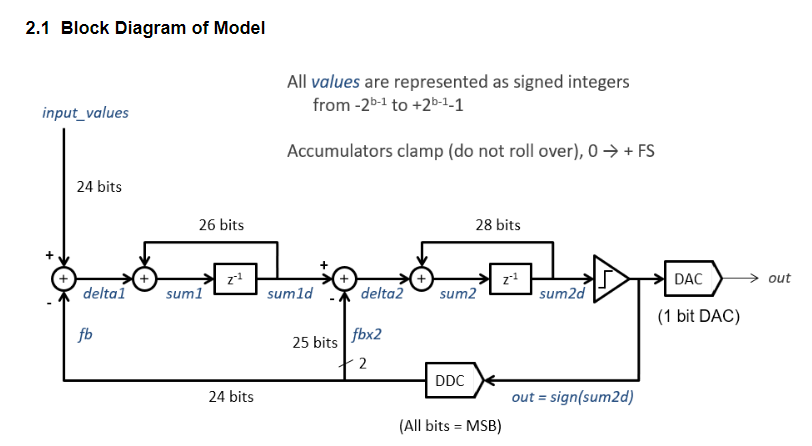hay i found my sigma delta MATLAB program. dunno if it's any good.
%
%
%
%
%
%
% simulated 1 bit sigma-delta converter:
%
%
% x(n)-y(n-1) w(n) v(n) ( mean(y^2) = A^2 )
%
% x ---->(+)--->[1/(z-1)]--->(+)--->[1/(z-1)]--->[Quantizer]----.---> y = +/- A = quantized value
% ^ ^ |
% | | |
% | '----[-fbg]<----. |
% | | |
% '------[-1]<------------------------'------[1/z]<-----'
%
%
%
%
%
% "linearized" model:
% .---- q = quantization noise ( mean(q) = 0 )
% |
% |
% x - y/z w v | ( mean(y^2) = G^2*mean(v^2) + mean(q^2) )
% v
% x ---->(+)--->[1/(z-1)]--->(+)--->[1/(z-1)]--->[G]--->(+)-----.---> y = G*v + q
% ^ ^ |
% | | |
% | '----[-fbg]<----. |
% | | |
% '------[-1]<------------------------'------[1/z]<-----'
%
%
%
%
%
%
%
%
% W = 1/(z-1)*(X - Y/z)
%
%
% V = 1/(z-1)*(W - fbg*Y/z)
%
% = (X - Y/z - fbg*Y*(z-1)/z)/(z-1)^2
%
% = (X*z - Y*(1+fbg*(z-1))) / (z*(z-1)^2)
%
%
% Y = G*V + Q = G*(X*z - Y*(1+fbg*(z-1)))/(z*(z-1)^2) + Q
%
% = G*X/(z-1)^2 - G*Y*(1+fbg*(z-1))/(z*(z-1)^2) + Q
%
%
% Y + G*Y*(1-fbg + fbg*z)/(z*(z-1)^2) = G*X/(z-1)^2 + Q
%
%
% Y = (G*X/(z-1)^2 + Q)/(1 + G*(1-fbg + fbg*z)/(z*(z-1)^2))
%
% = (G*X/(z-1)^2 + Q)*(z*(z-1)^2)/((z*(z-1)^2) + G*(1-fbg + fbg*z))
%
% = z*(G*X + Q*(z-1)^2)/(z^3 - 2*z^2 + (G*fbg+1)*z + G*(1-fbg))
%
% = z*(G*X + Q*(z-1)^2)/(z*(z-1)^2 + G*fbg*z + G*(1-fbga))
%
%
% as z -> 1 (DC)
%
% Y -> z*X/(fbg*z + (1-fbg)) = X/(fbg + (1-fbg)/z) --> X
%
%
if ~exist('mean_vv', 'var')
linearized_model = 0 % run this with 0 the first time to define G and mean(q^2)
end
if ~exist('A', 'var')
A = 1.0 % comparator output magnitude
end
if ~exist('fbg', 'var')
fbg = 2.0 % feedback gain to internal integrator
end
%
% if there is an input soundfile specified, use it. else, create a sin wave
%
if exist('inputFile', 'var')
[inputBuffer, Fs] = audioread(inputFile);
fileSize = length(inputBuffer);
numSamples = 2.^(ceil(log2(fileSize(1)))); % round up to nearest power of 2
x = zeros(numSamples, 1); % zero pad if necessary
x(1:fileSize) = inputBuffer(:,1); % if multi-channel, use left channel only
clear inputBuffer; % free this memory
clear fileSize;
t = linspace(0.0, (numSamples-1)/Fs, numSamples); % time
else
if ~exist('numSamples', 'var')
numSamples = 65536 % number of samples in simulation
end
if ~exist('Fs', 'var')
Fs = 44100 % (oversampled) sample rate
end
if ~exist('f0', 'var')
f0 = 261.6255653 % input freq (middle C)
end
if ~exist('Amplitude', 'var')
Amplitude = 0.25 % input amplitude
end
t = linspace(0.0, (numSamples-1)/Fs, numSamples); % time
x = Amplitude*cos(2*pi*f0*t); % the input
end
sound(x, Fs); % listen to input sound
pause;
y = zeros(1, numSamples); % the output (created and initialized for speed later)
if linearized_model
% artificial quantization noise for linearized model
% mean(q) = 0, var(q) = mean(q^2) = mean(y^2) - G^2*mean(v^2)
% does not have to be uniform or triangle p.d.f.
q = sqrt(6.0*(A^2 - G^2*mean_vv))*( rand(1, numSamples) - rand(1, numSamples) );
else
q = zeros(1, numSamples);
end
sum_yv = 0.0;
sum_vv = 0.0;
w = 0;
v = 0;
for n = 1:numSamples
if linearized_model
y(n) = G*v + q(n); % here the comparator is modelled as a little gain with additive noise
else
if (v >= 0) % the comparator
y(n) = +A;
else
y(n) = -A;
end
q(n) = y(n) - (sum_vv+1e-20)/(sum_yv+1e-20)*v;
end
sum_yv = sum_yv + y(n)*v; % collect some statistics on v
sum_vv = sum_vv + v*v;
v = v + w - fbg*y(n); % second integrator
w = w + x(n) - y(n); % first integrator
end
if ~linearized_model % don't recalculate this if using the linearized model
mean_yv = sum_yv/numSamples;
mean_vv = sum_vv/numSamples;
G = mean_yv/mean_vv; % the apparent comparator gain (assuming stationary input)
end
%
%
%
% Y = ((G*z)*X + (z^3 - 2*z^2 + z)*Q) / (z^3 - 2*z^2 + (G*a+1)*z + G*(1-a))
%
%
%
Hx = freqz([0 0 G 0], [1 -2 G*fbg+1 G*(1-fbg)], numSamples/2);
Hq = freqz([1 -2 1 0], [1 -2 G*fbg+1 G*(1-fbg)], numSamples/2);
plot(t, y, 'b');
sound(y, Fs); % this could sound pretty bad
pause;
Y = fft(fftshift(y .* kaiser(numSamples, 5.0)'));
Q = fft(fftshift(q .* kaiser(numSamples, 5.0)'));
f = linspace(0.0, (numSamples/2-1)/numSamples*Fs, numSamples/2);
plot(f, 20*log10(abs(Y(1:numSamples/2)) + 1e-10), 'b');
hold on;
plot(f, 20*log10(abs(Q(1:numSamples/2)) + 1e-10), 'r');
plot(f, 20*log10(abs(Hq) + 1e-10), 'g');
axis([0 Fs/2 -50 100]);
hold off;
pause;
semilogx(f(2:numSamples/2), 20*log10(abs(Y(2:numSamples/2)) + 1e-10), 'b');
hold on;
semilogx(f(2:numSamples/2), 20*log10(abs(Q(2:numSamples/2)) + 1e-10), 'r');
semilogx(f(2:numSamples/2), 20*log10(abs(Hq(2:numSamples/2)) + 1e-10), 'g');
axis([Fs/numSamples Fs/2 -50 100]);
hold off;
pause;
semilogx(f(2:numSamples/2), 20*log10(abs(Y(2:numSamples/2)) + 1e-10), 'b');
hold on;
semilogx(f(2:numSamples/2), 20*log10(abs(Hq(2:numSamples/2)) + 1e-10), 'r');
semilogx(f(2:numSamples/2), 20*log10(abs(Hx(2:numSamples/2)) + 1e-10), 'g');
axis([Fs/numSamples Fs/2 -50 110]);
hold off;


